RecipeTin Eats' step-by-step guide to making sushi rolls
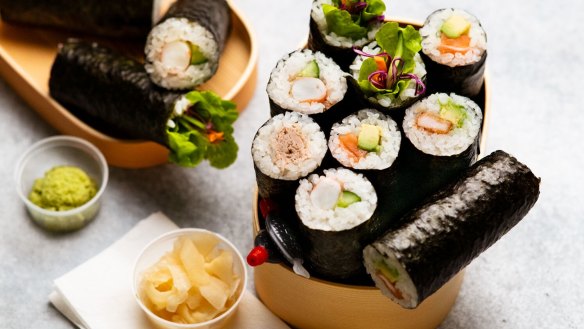
Up your street cred by producing these homemade takeaway-style sushi rolls for your lunchbox.
As a child, I got sent to school with bento boxes when all I wanted was a Vegemite sandwich. At lunchtime, I'd enviously eye off my friends' pink My Little Pony lunchboxes filled with "normal" things like apples, snack packs, and devon sandwiches.
Me, I'd pull out my bamboo bento box filled with sushi rolls, rice crackers and pickled radish, and field questions about my "weird" food. Little did I know back then that my mother was way ahead of the curve. I'd be the cool kid at school these days.
Related Article
As second term begins, send your kids to school with these takeaway-style sushi rolls, and make them for work lunches while you are at it.
This recipe, courtesy of my mother, Yumiko Maehashi, is adapted from her website, RecipeTin Japan.
Sushi rolls
A bamboo sushi rolling mat is essential – it allows you to roll the sushi up tightly without leaving fingerprints. Luckily, they're widely available these days even at supermarkets and only cost a couple of dollars – cheaper than buying a sushi roll!
I've provided four filling options, each of which makes four long rolls, which you'll cut in half to finish with eight rolls.
INGREDIENTS
Sushi rice
- 400g (2 cups) sushi rice, rinsed (see note)
- 2½ cups water
Sushi rice seasoning
- ¼ cup rice vinegar
- 2 tsp white sugar
- ¼ tsp salt
For the sushi rolls
- 5 cups cooked sushi rice (800g)
- 4 pieces of 19cm x 14cm nori sheet (2 standard nori sheets)
- sushi filling (choose one from the options below)
- Japanese soy sauce, wasabi and pickled ginger (gari) to serve
Vinegar water
- ½ cup water mixed with 1 tbsp rice vinegar
Filling options
Prawn and cucumber
- 12 medium raw whole prawns
- 1 Lebanese cucumber
- 12 short skewers (or long toothpicks)
Raw salmon and avocado
- 150g sashimi salmon
- 1 medium avocado
Teriyaki chicken and cucumber
- 1½ tbsp Japanese soy sauce (see note)
- 1½ tbsp cooking sake (see note)
- 1½ tbsp mirin (see note)
- 2 tsp caster sugar
- 2 x 160g skinless chicken thigh fillets
- 1 tbsp canola oil
- 1 tbsp water
- 1 Lebanese cucumber
Canned tuna dressed in mayonnaise
- 250g canned tuna in brine
- 2 tbsp Kewpie mayonnaise
- pinch white pepper
Vegetarian
- 8 green oak, coral or butterleaf lettuce leaves (soft leaves)
- ⅓ cup finely julienned carrots
- ⅓ cup very finely shredded red cabbage
- ⅓ cup thinly sliced on the diagonal and julienned cucumbers
Equipment
- Sushi rolling bamboo mat or soft cardboard (see note)
METHOD
- To cook the sushi rice, place water and rice in a large saucepan over medium-high heat (no lid). As soon as it comes to a boil, lower heat to medium-low, place lid on and leave for 18-20 minutes or until water is completely absorbed (quickly lift lid to check). DO NOT stir during the covered cooking time!
- Remove saucepan from the stove with the lid still on and leave to cool, undisturbed, for 15 minutes.
- Mix the sushi rice seasoning ingredients together in a small bowl until the sugar has dissolved.
- Spread the rice out on a large (23cm x 33cm) baking dish (or a purpose-made wooden sushi rice mixing tub, if you happen to have one). Drizzle half the sushi rice seasoning all over and, using a rice paddle or rubber spatula, cut through the rice and gently fold it over to mix the seasoning through. After 1 minute of mixing, drizzle remaining seasoning and repeat. Leave rice to cool and dry for about 20 minutes.
To prepare the prawns and cucumber, remove the prawn heads and devein (see note), inserting a skewer into the flesh of each prawn from the head end through to the tail to keep them straight as they cook. Bring a saucepan of water to the boil. Add prawns and cook for 2 minutes, then drain in a colander. Remove the skewers while the prawns are hot (it's easier than when cool), then leave the prawns to cool. Once the prawns are cool enough to handle, peel (and devein, if needed). Cut the cucumber into strips 7mm wide, trimming off and discarding the watery seeds. Then cut each strip into 7mm batons.
To prepare the salmon and avocado, cut the salmon into strips, each about 1.5cm x 1.5cm. The length will depend on the size of your salmon fillet. Cut the avocado into 1cm thick slices, then into strips 1cm wide.
To prepare the teriyaki chicken and cucumber, butterfly or trim the chicken thighs slightly so they are of roughly even thickness. This helps them cook through evenly. Mix together the soy sauce, sake, mirin and sugar in a medium bowl. Add chicken thighs and turn to coat. Set aside for 30 minutes, or overnight in the fridge. Heat the oil in a nonstick frypan over medium-high heat. Remove chicken from the marinade and place in the frypan, smooth side down. Reserve marinade. Cook the chicken for 4 minutes until golden brown, then turn and cook the other side for 3 minutes. Pour the reserved marinade and water into the pan, stir, then bring to a simmer for 1 minute or until the teriyaki sauce becomes a bit syrupy. Turn the chicken to coat in the sauce, then remove chicken and sauce to a bowl and allow to cool to room temperature before cutting the chicken into long strips 1.5cm wide. Cut the cucumber as for the prawn filling above.
To prepare the tuna mayonnaise, drain the tuna and place in a small bowl with remaining ingredients and mix together.
To prepare the vegetarian filling, wash then gently dry the lettuce leaves. Set aside with the other prepared vegetables until required.
How to roll
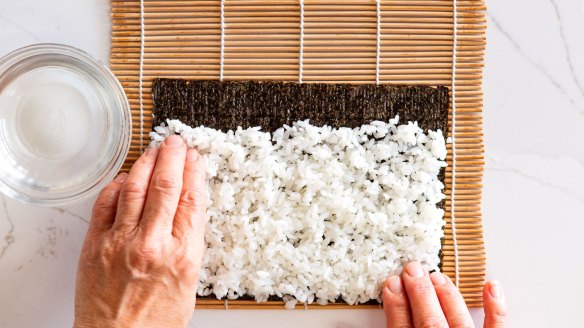
STEP ONE
Place a nori sheet on a sushi rolling mat, smooth side down and long side towards you. Lightly wet your hands with the vinegar water. Take ¼ of the seasoned sushi rice and form a ball with your hands. Place the rice in the centre of the nori sheet then use your fingers to evenly spread the rice, leaving a 2cm border on the side furthest from you.
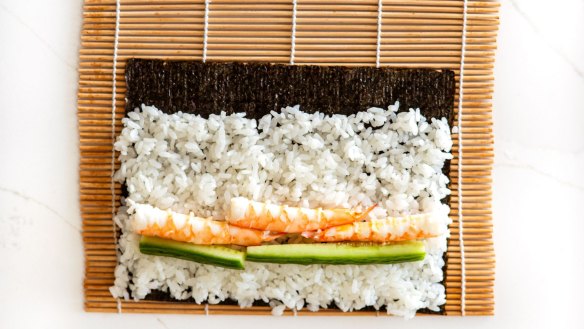
STEP TWO
Place your choice of fillings onto the nori sheet on the nearest third, connecting them as needed to fill the length of the sushi roll.
For the salmon, prawn and teriyaki chicken rolls, place the fillings onto the nori sheet on the nearest third. Use a single layer of each ingredient, connecting the pieces as needed to fill the length of the sushi roll.
For the tuna mayonnaise, spread ¼ of the tuna filling across the sushi roll in a 1.5cm wide strip.
For the vegetarian sushi roll, start with the lettuce leaves then place the remaining fillings on top, using ¼ of each ingredient in each sushi roll.
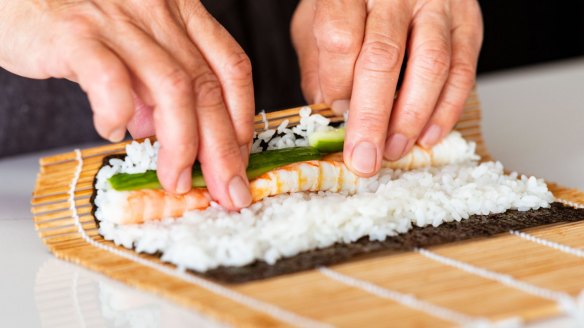
STEP THREE
Lift the near edge of the mat over the filling, using your fingers to hold everything in place. With both hands, use the mat to firmly roll up the sushi roll, applying even pressure.
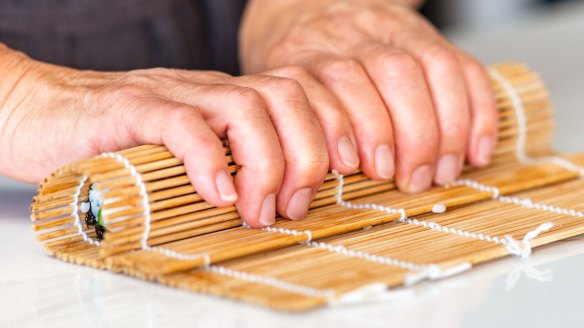
STEP FOUR
Pull the top edge of the mat out from under the roll as you go. Don't let the end of the bamboo mat roll under your sushi roll or it will leave an unsightly dent!
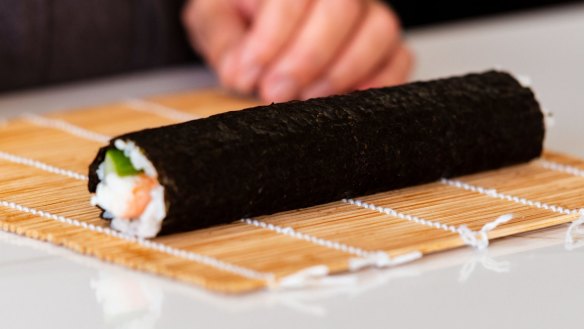
STEP FIVE
Once your sushi roll is rolled up inside the bamboo mat, press it together firmly with both hands to make it a neat roll shape, then gently remove the bamboo mat. Repeat for 3 remaining rolls.
STEP SIX
Allow the sushi rolls to rest for 5 minutes, seam side down. Wipe a sharp knife with a wet towel (this stops the rice from sticking to the knife), then cut each roll in half through the middle to form 2 sushi rolls. Wipe the knife with the wet towel each time before cutting remaining rolls.
STEP SEVEN
Serve immediately with Japanese soy sauce, wasabi and pickled ginger (gari) to taste. Use the cut face of the roll as the presentation side (with the exception of the vegetable roll as the end with the vegetables poking out is prettier!). Sushi rolls are best when freshly made. The salmon sushi should be consumed straight away. The other sushi rolls can be refrigerated for up to 24 hours, or packed in a thermal lunchbox to keep cold until lunch time. Wrap each roll individually in clingwrap otherwise they will stick to each other.
Notes
- Sushi rice – a particular type of short grain white rice that is kind of sticky, which makes it suitable for making sushi. It is also a bit more absorbent, so it can take up the sushi rice seasoning without going mushy. Sold in packets helpfully labelled "sushi rice".
- Rinsing rice – place in colander, and swish around with your hands under running water for 15 seconds. Drain off excess water well before transferring to a saucepan.
- Sushi bamboo mats – these days, bamboo mats are readily available, even sold at large grocery stores. If you don't have one, use a piece of cardboard soft and pliable enough to roll the sushi up tightly and squeeze it firmly without leaving fingerprints on the sushi roll.
- Deveining the prawn – when you remove the head of the prawn, you will see the end of the vein. Straighten the prawn with your hand then carefully pull the vein out. If it breaks, don't worry! Just remove the vein once the prawn is cooked by cutting a slit down the back of the prawn and removing the shell.
- Japanese soy sauce – it has a milder, smoother flavour than Chinese soy sauce. My family uses Kikkoman brand. If you can't find Japanese soy sauce, substitute light soy sauce.
- Cooking sake – Japanese cooking wine, made from fermented rice, contains salt. The closest substitute is Chinese cooking wine.
- Mirin – this sweet cooking wine is a Japanese pantry essential. Like cooking sake, it is widely available in Asian grocery stores and the Asian section of supermarkets.
Appears in these collections
The best recipes from Australia's leading chefs straight to your inbox.
Sign upFrom our partners
Original URL: https://www.smh.com.au/goodfood/tips-and-advice/recipetin-eats-stepbystep-guide-to-making-sushi-rolls-20220401-h22uaw.html
